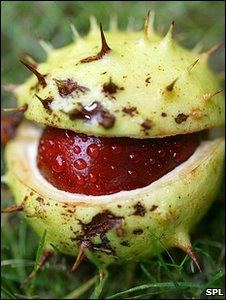DNA boost in battle against bleeding canker
- Published

"Conkers" is a popular game in school playgrounds during the autumn
A team of UK scientists hopes to shed light on the mysteries of bleeding canker, a disease that is threatening the nation's horse chestnut trees.
The researchers have sequenced the genome of a strain of bacterium that causes the virulent infection.
A survey in 2007 showed that bleeding canker had spread rapidly, with almost half of the two million horse chestnuts displaying symptoms of the disease.
The findings have been published in the journal PLoS One.
A visible symptom of the disease is a lesion on the bark, which oozes a resin on to the trunk or sometimes the branches.
The bark underneath the canker is killed, and if cankers manage to go all the way around the trunk then the horse chestnut (Aesculus hippocastanum) will die because it cuts off the food supply.
'Single introduction'
The researchers sequenced the genome of the bacterium Pseudomonas syringae pathovar aesuli (Pae) from three samples collected from different locations within the UK. They compared them with samples from the only other recorded case, taken from an Indian horse chestnut in India in the 1960s.
"What we found was that the three British samples were all identical," said co-author Dr David Studholme, currently at the University of Exeter but who was based at The Sainsbury Laboratory, Norwich, while during the study.
"This means that they all probably descended from a single introduction," he told BBC News.
However, he added that more work was needed before they could say whether or not the bacterium originated from India, where the pathovar (a strain of bacterium that only affects certain plants, in this case horse chestnuts) was originally recorded.
"The Indian [specimen] has only ever been known to cause a leaf spot; there is no evidence of it causing cankers."
Dr Studholme's fellow co-author was Sarah Green, a plant pathologist at Forest Research, the research wing of the UK Forestry Commission. She said Pae was "very mobile, very aggressive" and that it definitely needed to be studied.
"There were some interesting genes that we found that may well be helping it to be so aggressive," she explained.
"It affects the woody part of the trees, whereas other bacterial diseases attack the soft tissues (such as leaves)."
However, she added that much more work was needed before it would be possible to understand how the bacterial strain interacted with the trees and how it was spread.
Chainsaw reaction
Since Pae was first recorded in 2002, it has become present throughout the UK and more than 70% of horse chestnuts in some areas are showing symptoms of being infected.
Roddie Burgess, head of plant health at the Forestry Commission, said he hoped the research would help develop a strategy to tackle the problem.
"It always takes you by surprise when you investigate a previously unknown disease and find out that almost half of your tree population may already be infected," he told BBC News.
He said that a few thousand trees were known to have been cut down by local authorities amid fears that infected trees would pose a risk to the public.
"Quite a hefty number were felled before we realised that the trees sometimes go into remission and maybe recover.
"Our advice for now is not to go jumping in with a chainsaw."
He added that further research was underway to find out if the disease had the potential to kill the trees in ways other than cutting off the supply of nutrients.
"These are the sorts of things we need to understand before we even begin to think about how best to manage infected trees."